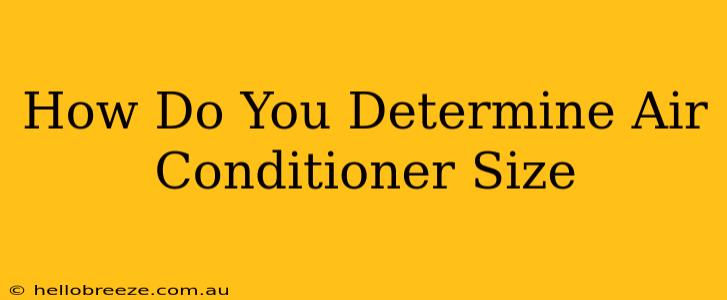Choosing the right air conditioner size is crucial for comfort and energy efficiency. An undersized unit will struggle to cool your space, leading to high energy bills and poor performance. Conversely, an oversized unit will cycle on and off too frequently, failing to dehumidify properly and again, wasting energy. This guide will walk you through how to determine the appropriate air conditioner size for your needs.
Understanding BTU Ratings: The Key to Air Conditioner Sizing
The British Thermal Unit (BTU) is the measurement of cooling power. A higher BTU rating means more cooling capacity. Finding the right BTU rating is the cornerstone of selecting the correct air conditioner size. Don't just guess—accurate calculation is essential.
Factors Influencing BTU Requirements:
Several factors influence the BTU requirement for your space. Failing to consider these will result in an improperly sized unit.
- Room Size: This is the most obvious factor. Larger rooms require more cooling power. Measure the length and width of the room to calculate the square footage.
- Ceiling Height: Higher ceilings require more BTUs to cool the entire volume of air.
- Number of Windows and Their Size: South-facing windows, in particular, let in significantly more heat, increasing the cooling demand. Larger windows also increase this effect.
- Window Type and Insulation: Double- or triple-paned windows with good insulation will reduce the cooling load compared to single-pane windows.
- Insulation Levels: Proper wall and ceiling insulation significantly reduces heat transfer, lowering your BTU needs. Poor insulation means you'll need a larger unit.
- Number of Occupants: People generate heat, so more occupants mean a higher cooling demand.
- Appliances and Electronics: Appliances and electronics generate heat, adding to the cooling load.
- Climate and Outdoor Temperature: In hotter climates, you'll need a higher BTU rating to overcome the external heat.
- Direct Sunlight: Rooms with significant direct sunlight exposure require higher BTU ratings.
Calculating Your BTU Requirements: A Step-by-Step Guide
While online BTU calculators are readily available, understanding the process gives you more control. Here's a simplified approach:
- Calculate the square footage: Multiply the length and width of the room.
- Consider the factors above: Carefully assess each factor's impact. For example, a south-facing room with large windows might require significantly more BTUs than a similar-sized room with north-facing windows and good insulation.
- Use a BTU calculator: Numerous online calculators incorporate these factors for a more precise estimate. Input your data and let the calculator provide a BTU recommendation. Remember to carefully verify the accuracy of your input.
- Consider a slightly larger unit: It's generally better to err on the side of caution. A slightly oversized unit is more efficient than an undersized one, which will constantly run at maximum capacity. However, avoid oversizing excessively.
Beyond BTU: Other Important Considerations
While BTU is the primary factor, don't overlook other crucial elements:
- Energy Efficiency (SEER Rating): The Seasonal Energy Efficiency Ratio (SEER) measures the unit's energy efficiency. A higher SEER rating means lower energy bills.
- Type of Air Conditioner: Choose the right type for your needs: window, portable, split system, etc. Consider factors like installation complexity and noise levels.
- Maintenance: Regular maintenance is crucial for optimal performance and longevity. Clean filters and coils regularly to maximize efficiency.
Conclusion: Finding the Perfect AC Size for Your Comfort
Determining the correct air conditioner size is a crucial step to ensure optimal cooling, energy efficiency, and comfort. By carefully considering the factors discussed and using a BTU calculator, you can find the perfect fit for your space and enjoy cool comfort throughout the warmer months. Remember to always consult with a qualified HVAC professional for expert advice and installation.

